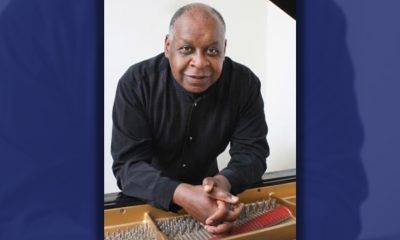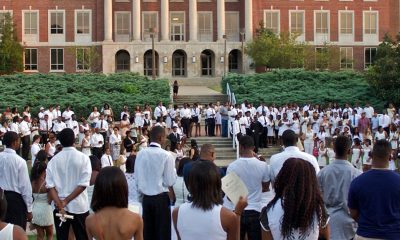Black History
PRESSROOM: Legislation Introduced to Establish African Burial Ground Museum In New York
NNPA NEWSROOM: The African Burial Ground is a cemetery in Manhattan that’s considered the oldest and largest known burial ground in North America for free and enslaved Africans. It serves great historical, cultural, archaeological and anthropological significance, officials said.
By Stacy M. Brown, NNPA Newswire Correspondent
@StacyBrownMedia
Members of the New York Democratic delegation, led by U.S. Senate Minority Leader Charles E. Schumer, U.S. Senator Kirsten Gillibrand and U.S. Representative Jerrold Nadler, joined Representatives Gregory Meeks, Yvette Clarke, and Adriano Espaillat, this week in announcing the reintroduction of the African Burial Ground International Memorial Museum and Education Act.
The legislation would establish a museum and education center at the African Burial Ground in Manhattan, a site that currently holds the remains of an estimated 15,000 free and enslaved Africans and early-generation African-Americans from the colonial era, according to a news release from Schumer’s office.
The museum would be managed by the National Park Service in consultation with the African Burial Ground Advisory Council, which would be established by new legislation.
“The African Burial Ground is culturally and historically significant to New York and the nation,” Schumer said.
“The establishment of a museum and an education center at this cemetery will illuminate the plight, courage and humanity of the free and enslaved Africans who helped create New York,” he said.
The African Burial Ground is a cemetery in Manhattan that’s considered the oldest and largest known burial ground in North America for free and enslaved Africans. It serves great historical, cultural, archaeological and anthropological significance.
The burial ground includes DNA samples from the remarkably well-preserved human remains that will enable researchers to trace the home roots in Africa of those individuals buried there.
The site became a National Historic Landmark in 1993 and was designated as a national monument in 2006.
“As a nation, we must always remember the tremendous burdens and afflictions experienced by those who were brought here in bondage, and who fought – for generations – against impossible odds to achieve the full measure of dignity and equality and justice that they were due,” Schumer said.
“I am proud to cosponsor this legislation and I urge my colleagues to pass this bill and for the president to sign it into law,” he said.
“The burial ground serves as a tribute to the enslaved and free African men and women who lived in and helped build New York,” said Gillibrand. “Establishing a museum and an education center at this location would memorialize their stories and protect their legacies.”
“This is an important part of New York’s history that deserves to be recognized. I am proud to work with my colleagues in the New York delegation to introduce this legislation and urge my colleagues in Congress to pass this bill,” Gillibrand continued.
Nadler added that, “on the site of the African Burial Ground lie the remains of thousands of free and enslaved early African residents of New York, making it a site of the utmost historic and cultural significance for New York City and the United States.”
“A Memorial Museum and Education Center on those grounds will pay respects to the thousands buried there, acknowledge the central role that enslaved and free African men and women played in building New York City from its earliest history, and educate Americans and other visitors about the profound and far-reaching impact of slavery on American society,” he said.
From the beginnings of the colonial past to long after the formation of the union, enslaved Africans and their descendants have endured bondage and forced labor, followed by segregation and discrimination in America, Meeks said.
“Their resiliency should be commemorated, and their plight: never forgotten. Constructing the African Burial Ground Memorial Museum will serve to commemorate their bravery, remind us how long the journey towards justice has been, and contextualize the historical roots of the inequities that still persist to this day,” he said.
The sacred African Burial Ground Memorial Museum and Education Center will serve as a tool to educate communities on the long-lost history of the enslaved and freed African-Americans, whose labor ultimately built the City of New York, said Clarke.
“Amid the fight for equity, justice and fairness, we must shed light on the human rights violations that occurred in both colonial and federal New York City during the 17th and 18th centuries. This history deserves to be honored, remembered and studied by all Americans to ensure that such cruelties never occur again,” Clarke said.
Espaillat added that this year marks 400 years since the first African slaves were brought to the United States and the beginning of one of the darkest periods of our nation’s history.
“Establishing the burial ground is a tremendous way to reflect on the significant suffering and injustice slavery had throughout the United States,” Espaillat said.
“We can never forget the horrors that were inflicted through slavery, and the African Burial Ground Memorial will play a vital role in our ability to better understand the past and honor the history that all groups of people have had on American culture and our continued crusade for freedom and justice for all,” he said.
Activism
Oakland Post: Week of April 24 – 30, 2024
The printed Weekly Edition of the Oakland Post: Week of April 24 – 30, 2024

To enlarge your view of this issue, use the slider, magnifying glass icon or full page icon in the lower right corner of the browser window. ![]()
Activism
Oakland Post: Week of April 17 – 23, 2024
The printed Weekly Edition of the Oakland Post: Week of April 17 – 23, 2024

To enlarge your view of this issue, use the slider, magnifying glass icon or full page icon in the lower right corner of the browser window. ![]()
Black History
Matthew Henson: Explorer Extraordinaire
Matthew Henson, a trailblazing explorer who overcame countless obstacles to leave an incredible mark on history. Born on August 8, 1866, in Charles County, Maryland, his journey is a testament to the power of determination and the spirit of adventure.

By Tamara Shiloh
Matthew Henson, a trailblazing explorer who overcame countless obstacles to leave an incredible mark on history. Born on August 8, 1866, in Charles County, Maryland, his journey is a testament to the power of determination and the spirit of adventure.
Henson’s life began amidst the backdrop of post-Civil War America, where opportunities for African Americans were scarce. From a young age, he possessed an insatiable curiosity about the world beyond his small town. At the age of 12, he embarked on a journey that would change the course of his life forever when he joined a merchant ship as a cabin boy.
His most famous expedition was his journey to the Arctic with renowned explorer Robert E. Peary. In 1887, Henson joined Peary’s crew as a seaman and quickly proved himself to be invaluable with his skills as a navigator and craftsman. Over the course of several expeditions, Matthew endured extreme cold, treacherous terrain, and grueling conditions as he and Peary sought to reach the elusive North Pole.
In 1908–09, Peary set out on his eighth attempt to reach the North Pole. It was a big expedition, with Peary planning to leave supplies along the way. When he and Henson boarded their ship, the Roosevelt, leaving Greenland on August 18, 1909, they were joined by a large group. This included 22 Inuit men, 17 Inuit women, 10 children, 246 dogs, 70 tons of whale meat, blubber from 50 walruses, hunting gear, and tons of coal.
In February, Henson and Peary left their anchored ship at Ellesmere Island’s Cape Sheridan, along with the Inuit men and 130 dogs. They worked together to set up a trail and supplies along the way to the Pole.
Peary picked Henson and four Inuit people to join him in the final push to the Pole. However, before they reached their destination, Peary couldn’t walk anymore and had to ride in a dog sled. He sent Henson ahead to scout the way. In a later interview with a newspaper, Henson recalled being in the lead and realizing they had gone too far. The group turned back, and Henson noticed his footprints helped guide them to their destination. At that location, Henson planted the American flag.
Henson’s legacy extends far beyond his expeditions to the Arctic. He shattered racial barriers in the world of exploration and inspired countless individuals, regardless of race, to dream big and pursue their passions. In 1937, he was finally recognized for his achievements when he was inducted into The Explorers Club, an organization dedicated to promoting scientific exploration and field research.
Matthew Henson died in the Bronx, New York, on March 9, 1955, at the age of 88.
-

 Community2 weeks ago
Community2 weeks agoFinancial Assistance Bill for Descendants of Enslaved Persons to Help Them Purchase, Own, or Maintain a Home
-

 Activism3 weeks ago
Activism3 weeks agoOakland Post: Week of April 3 – 6, 2024
-

 Business2 weeks ago
Business2 weeks agoV.P. Kamala Harris: Americans With Criminal Records Will Soon Be Eligible for SBA Loans
-

 Community2 weeks ago
Community2 weeks agoAG Bonta Says Oakland School Leaders Should Comply with State Laws to Avoid ‘Disparate Harm’ When Closing or Merging Schools
-

 Activism2 weeks ago
Activism2 weeks agoOakland Post: Week of April 10 – 16, 2024
-

 Community1 week ago
Community1 week agoOakland WNBA Player to be Inducted Into Hall of Fame
-

 Community1 week ago
Community1 week agoRichmond Nonprofit Helps Ex-Felons Get Back on Their Feet
-

 City Government2 weeks ago
City Government2 weeks agoLAO Releases Report on Racial and Ethnic Disparities in California Child Welfare System























































